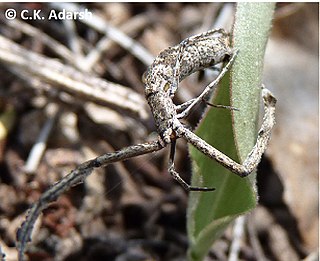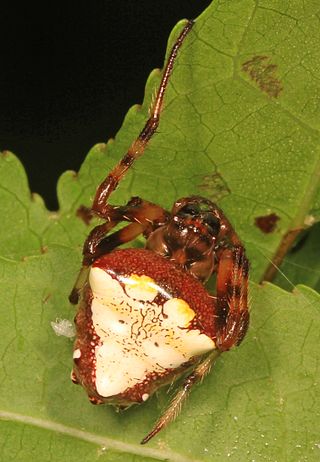
The genus Argiope includes rather large spiders that often have a strikingly coloured abdomen. These spiders are distributed throughout the world. Most countries in tropical or temperate climates host one or more species that are similar in appearance. The etymology of Argiope is from a Latin word argentum meaning silver. The carapace of Argiope species is typically covered in silvery hairs, and when crawling in the sun, they reflect it in a way that gives them a metallic, white appearance.

Uloboridae is a family of non-venomous spiders, known as cribellate orb weavers or hackled orb weavers. Their lack of venom glands is a secondarily evolved trait. Instead, they wrap their prey thoroughly in silk, cover it in regurgitated digestive enzymes, and then ingest the liquified body.

Orb-weaver spiders are members of the spider family Araneidae. They are the most common group of builders of spiral wheel-shaped webs often found in gardens, fields, and forests. The English word "orb" can mean "circular", hence the English name of the group. Araneids have eight similar eyes, hairy or spiny legs, and no stridulating organs.

Nephila is a genus of araneomorph spiders noted for the impressive webs they weave. Nephila consists of numerous species found in warmer regions around the world, although some species formerly included in the genus have been moved to Trichonephila. They are commonly called golden silk orb-weavers, golden orb-weavers, giant wood spiders, or banana spiders.

A stabilimentum, also known as a web decoration, is a conspicuous silk structure included in the webs of some species of orb-web spider. Its function is a subject of debate.

Philoponella is a genus of uloborid spiders. Like all Uloboridae, these species have no venom.

A spider web, spiderweb, spider's web, or cobweb is a structure created by a spider out of proteinaceous spider silk extruded from its spinnerets, generally meant to catch its prey.

Metepeira labyrinthea, the labyrinth orbweaver, is a spider, with thin legs and a round, bulbous abdomen It is a member of the genus Metepeira in the family Araneidae. The female’s length is 5.3 mm, its carapace 2.3 mm, abdomen 3.3 mm, and extended legs 18.4 mm. The carapace is brown or gray, and the abdomen is dark with a white pattern. The legs alternate pale brown and dark brown, and the sternum is dark brown with a longitudinal yellow mark. The male spider is three-quarters of the female’s length, or slightly larger, with a darker carapace and with greater contrast between dark and light areas of the legs. Metepeira are easily distinguished from other Araneidae by their light eye region, white median line on the sternum, relative length of the leg segments, small male palpus, weakly sclerotized epigyne and the special composite web.

Arachnura melanura, also known as scorpion tailed orb-weaver, black tail spider and drag tail spider is a species of spider in the family Araneidae. It ranges from India to Japan to Sulawesi. It camouflages itself by mimicking fallen flowers, dead leaves and twigs. It replaces the capture spiral of its web daily.

Spiders are air-breathing arthropods that have eight limbs, chelicerae with fangs generally able to inject venom, and spinnerets that extrude silk. They are the largest order of arachnids and rank seventh in total species diversity among all orders of organisms. Spiders are found worldwide on every continent except Antarctica, and have become established in nearly every land habitat. As of September 2024, 52,309 spider species in 134 families have been recorded by taxonomists. However, there has been debate among scientists about how families should be classified, with over 20 different classifications proposed since 1900.

Araneus mitificus, commonly known as the kidney garden spider or pale orb weaver is a species of orb-weaver spider found in South, East, and Southeast Asia.

Hyptiotes paradoxus, also known as the triangle spider, is a cribellate orbweaver in the family Uloboridae.

Orbiculariae is a potential clade of araneomorph spiders, uniting two groups that make orb webs. Phylogenetic analyses based on morphological characters have generally recovered this clade; analyses based on DNA have regularly concluded that the group is not monophyletic. The issue relates to the origin of orb webs: whether they evolved early in the evolutionary history of entelegyne spiders, with many groups subsequently losing the ability to make orb webs, or whether they evolved later, with fewer groups having lost this ability. As of September 2018, the weight of the evidence strongly favours the non-monophyly of "Orbiculariae" and hence the early evolution of orb webs, followed by multiple changes and losses.

Miagrammopes is a genus of cribellate orb weavers first described by Octavius Pickard-Cambridge in 1870. These spiders have a unique shape and only four of their original eight eyes. They spin a single line of web, actively watching and jerking the line to catch their prey.

Verrucosa arenata, also known as the triangle orb weaver, arrowhead spider, and arrowhead orbweaver, is a species of orb-weaver spider found across North America. It is one of the few known large orb-weaver spiders that sits facing upwards in its web. Unlike most orb-weavers, which have bulbous abdomens, V. arenata has an abdomen that is pointy and triangular, shaped like the tip of an arrow. In females, the abdomen is colored white or yellow. Additionally, V. arenata uses reeling behavior in order to capture its prey, as its webs are stronger than that of most other orb weavers. The genus name Verrucosa means "warty" in Latin, referring to the small wartlike bumps on the spider's abdomen, while the specific epithet arenata derives from Latin arena, meaning "sand".
Conifaber is a genus of spiders in the family Uloboridae. It was first described in 1982 by Opell. As of 2017, it contains 4 species, all from South America:
Lubinella is a genus of spiders in the family Uloboridae. It was first described in 1984 by Opell. This genus was named after arachnologist Yael D. Lubin. As of 2017, it contains only one species, Lubinella morobensis, from New Guinea.

Octonoba is a genus of Asian cribellate orb weavers first described in 1979 by Brent Opell. Members of this genus and those of Purumitra both have a large concave median apophysis and a conspicuous hematodocha. However, these spiders are generally much larger, with a carapace greater than 1.4 millimeters long, where those of Purumitra are usually less than 1 millimeter long.

Waitkera is a genus of spiders in the family Uloboridae. It was first described in 1979 by Opell. As of 2021, it contains only one species, Waitkera waitakerensis, found in New Zealand.
Hyptiotes puebla is a species of cribellate orb weaver in the family of spiders known as Uloboridae. It is found in the United States and Mexico.

















